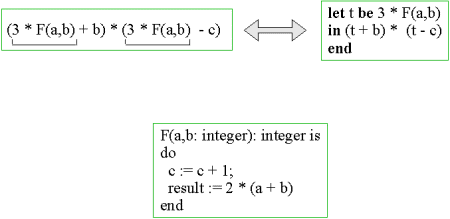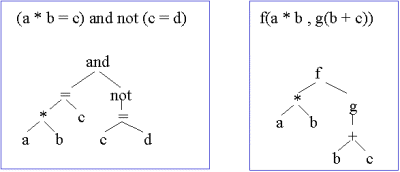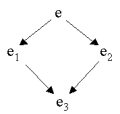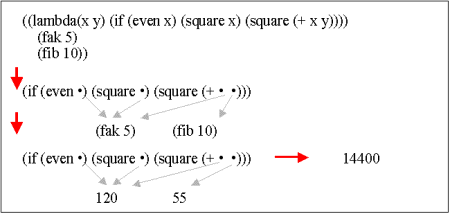
Kurt Nørmark
Department of Computer Science, Aalborg University, Denmark
| Abstract Previous lecture Index References Contents | In this lecture we will study the impact of the order of evaluation. |
| Referential Transparency |
| Program: The forms discussed. |
|
| Referential transparency Slide Annotated slide Contents Index References |
|
|
|
|
| An illustration of referential transparency Slide Annotated slide Contents Index References |
|
| Figure. It is possible to rewrite one of the expressions above to the other, provided that F is a pure function. Below, we have illustrated an example where F is of procedural nature. Notice that F assigns the variable c, such that it becomes critical to know how many times F is called. |  |
| Introduction to Evaluation Order |
| Arbitrary evaluation order - with some limits Slide Annotated slide Contents Index References |
|
| Figure. An illustration of an expression with subexpressions. In this context we will assume that and is defined as a function. In Scheme, and is not definede as a function, because of the short circuit evaluation rule. If and is short circuited the evaluation order of the surrounding expression is constrained. |  |
|
| Infinite evaluations and error evaluations Slide Annotated slide Contents Index References |
|
| Program: Constant functions with problematic actual parameter expressions.
|
|
| Program: A more concrete version of the infinite calculation from above. The function infinite-calculation just calls itself without ever terminating. |
|
| Infinite evaluations and error evaluations - clarification Slide Annotated slide Contents Index References |
|
| Program: Constant functions with problematic actual parameter expressions.
|
|
|
|
| Rewrite rules, reduction, and normal forms |
| Rewrite rules Slide Annotated slide Contents Index References |
|
|
| The alpha rewrite rule Slide Annotated slide Contents Index References |
|
| The concept alpha conversion: Formal parameters of a lambda expression can be substituted by other names, which are not used as free names in the body |
| Legal conversion: |
| Table. An example of an alpha rewriting. The name a replaces x and the name y replaces y. |
|
| Illegal conversion: |
| Table. Examples of an illegal alpha conversion. f is a free name in the lambda expression. A free name is used, but not defined (bound) in the lambda expression. In case we rename one of the parameters to f, the free name will be bound, hereby causing an erroneous name binding. |
|
|
| The beta rewrite rule Slide Annotated slide Contents Index References |
|
| The concept beta conversion: An application of a function can be substituted by the function body, in which formal parameters are substituted by the corresponding actual parameters |
| Legal conversions: |
| Table. Examples of beta conversions. In all the three examples the function calls are replaced by the bodies. In the bodies, the formal parameters are replaced by actual parameters. |
|
|
| The eta rewrite rule Slide Annotated slide Contents Index References |
|
| The concept eta conversion: A function f, which only passes its parameters on to another function e, can be substituted by e |
| (lambda(x) (e x)) <=> e provided that x is not free in the expression e |
| Legal conversion: |
| Table. An example of an eta rewriting. |
|
| Illegal conversion: |
| Table. An example of an illegal eta conversion. The eta conversion rule says in general how 'e' is lifted out of the lambda expressions. In this example, e corresponds to the emphasized inner lambda expression (which is blue on a color medium.) However, x is a free name in the inner lambda expression, and therefore the application of the eta rewrite rule is illegal. |
|
|
| Normal forms Slide Annotated slide Contents Index References |
|
| The concept normal form: An expression is on normal form if it cannot be reduced further by use of beta and eta conversions |
|
| Program: An example of a Scheme expression without a normal form. |
|
| Program: Scheme expressions - some of which are in normal form. |
|
|
|
| The ordering of reductions Slide Annotated slide Contents Index References |
|
| The concept normal-order reduction: Using normal-order reduction, the first reduction to perform is the one at the outer level of the expression (the leftmost reduction first). | ||
| The concept applicative-order reduction: Using applicative-order reduction, the first reduction to perform is the inner leftmost reduction. |
|
| An example of normal versus applicative evaluation Slide Annotated slide Contents Index References |
|
| Figure. Normal vs. applicative reduction of a Scheme expression |  |
| Program: The necessary Scheme stuff to evaluate the expression. |
|
|
| Theoretical results Slide Annotated slide Contents Index References |
|
| Figure. The rewriting => is confluent if for all e, e 1 and e 2 , for which e => e 1 and e => e 2 , there exists an e 3 such that e 1 => e 3 and e 2 => e 3 |  |
| The first Church-Rosser theorem. If e1 <=> e2 then there exists an e3 such that e1 => e3 and e2 => e3 |
|
| The second Church-Rosser theorem. If e0 => ... => en , and if en is on normal form,
then there exists a normal-order reduction of e0 to en |
|
|
| Practical implications Slide Annotated slide Contents Index References |
|
|
|
| Conditionals and sequential boolean operators Slide Annotated slide Contents Index References |
|
|
|
| Lazy evaluation Slide Annotated slide Contents Index References |
|
| The concept lazy evaluation: Lazy evaluation is an implementation of normal-order reduction which avoids repeated calculation of subexpressions |
| Figure. An illustration of lazy evaluation of a Scheme expression. Notice, that Scheme does not evaluate the expression in this way. Scheme uses applicative-order reduction. |  |
|
| Delayed evaluation and infinite lists in Scheme |
| Delayed evaluation in Scheme Slide Annotated slide Contents Index References |
|
| Syntax: |
|
| Syntax: |
|
| Program: A principled implementation of delay and force in Scheme. |
|
| Examples of delayed evaluation Slide Annotated slide Contents Index References |
| Table. Examples of use of delay and force. |
|
| Infinite lists in Scheme: Streams Slide Annotated slide Contents Index References |
|
| Program: Stream primitives. Notice the way head is defined to be an alias of car. |
| Program: An implementation of cons-stream in R5RS Scheme. |
|
|
| Example streams Slide Annotated slide Contents Index References |
| Table. Examples of streams. ones is an infinite streams of the element 1. stream-section is a function that returns a finite section of a potentially infinite stream. nat-nums is stream of all the natural numbers, made by use of the recursive function integers-starting-from. The fourth row shows an alternative definition of nat-nums. Finally, fibs is the infinite stream of Fibonacci numbers. |
|
| Program: The functions stream-section and add-streams. |
| Program: All Scheme stream stuff collected in one file. |
| Stream example: The Sieve of Eratosthenes Slide Annotated slide Contents Index References |
|
| Program: The sieve stream function. |
|
| Figure. An illustration of the generation of prime numbers in The Sieve of Eratosthenes |  |
| Applications of The sieve of Eratosthenes Slide Annotated slide Contents Index References |
|
| Table. The first 25 prime numbers made by sieving a sufficiently long prefix of the integers starting from 2. |
|
| Program: All the functions necessary to use the Sieve of Eratosthenes. In addition, however, you must load the Scheme stream stuff.
The most remarkable function is filter-streams, which illustrates that
it is necessary to rewrite all our classical higher order function to
stream variants. This is clearly a drawback! |
|
| Exercises Slide Annotated slide Contents Index References |
| Exercise 4.5. Finite streams | The function list produces a list of some given elements. Make a similar function stream that produces a stream of some given elements. As an example, (stream 1 2 3 4 5) should produce the finite stream of 1, 2, 3, 4 and 5. |
| Exercise 4.5. A stream of factorial numbers | Make a stream of all factorial numbers: 1 2 6 24 120 ... Please go for a recursive definition, in the same style as used for nat-nums and fib:
(define ones (cons-stream 1 ones))
(define nat-nums
(cons-stream 1
(add-streams ones nat-nums)))
(define fibs
(cons-stream 0
(cons-stream 1
(add-streams (tail fibs) fibs)))) As part of the solution, you may need a multiplicative stream function similar to add-streams. For that purpose make a higher-order function, combine-streams, that combines two (infinite) streams with a binary function. Here are all the necessary definitions you need to get started:
(define-syntax cons-stream
(syntax-rules ()
((cons-stream x y)
(cons x (delay y)))))
(define head car)
(define (tail stream) (force (cdr stream)))
(define empty-stream? null?)
(define the-empty-stream '())
(define (stream-section n stream)
(cond ((= n 0) '())
(else (cons (head stream)
(stream-section
(- n 1)
(tail stream))))))
(define (add-streams s1 s2)
(let ((h1 (head s1))
(h2 (head s2)))
(cons-stream
(+ h1 h2)
(add-streams (tail s1) (tail s2)))))
(define ones (cons-stream 1 ones))
(define nat-nums
(cons-stream 1
(add-streams ones nat-nums)))
|
| Exercise 4.5. Stream appending and stream merging | We have seen a number of useful stream funtions, as counterparts to well-known list functions. First, consider if/how to program a stream-append function, as a counterpart to append. Here is a possible recursive append function for lists:
(define (my-append lst1 lst2)
(cond ((null? lst1) lst2)
(else (cons (car lst1) (my-append (cdr lst1) lst2))))) How will your stream-append function work on infinite streams, such as nat-nums or fibs? Now program a similar function, stream-merge, that merges two streams by simple alternation. How will stream-merge function work on initinite streams? And on finite streams? Can you use stream-merge to produce as stream of all integers (in some arbitrary order), based on two other streams with fixed starting points? Here is all you need to get started:
(define-syntax cons-stream
(syntax-rules ()
((cons-stream x y)
(cons x (delay y)))))
(define head car)
(define (tail stream) (force (cdr stream)))
(define empty-stream? null?)
(define the-empty-stream '())
(define (stream-section n stream)
(cond ((= n 0) '())
(else (cons (head stream)
(stream-section
(- n 1)
(tail stream))))))
|
| Exercise 4.5. A stream that converges to the square root a number | It is well-known that the square root function can be implemented by use of Newton's method. In case you need some background, you can consult this video. If we need to find sqrt(x) based on an initial quess g, we can iteratively improve our guess by this simple function: (define (improve-sqrt-guess guess x) (/ (+ guess (/ x guess)) 2)) Produce a stream of real numbers, starting with the initial guess 1.0, that will converge towards sqrt(x). You may find the following stream variant of map useful:
(define (map-stream f stream)
(cond ((empty-stream? stream) the-empty-stream)
(else (cons-stream (f (head stream)) (map-stream f (tail stream)))))) Here is all you need to get started:
(define (improve-sqrt-guess guess x)
(/ (+ guess (/ x guess)) 2))
(define-syntax cons-stream
(syntax-rules ()
((cons-stream x y)
(cons x (delay y)))))
(define head car)
(define (tail stream) (force (cdr stream)))
(define empty-stream? null?)
(define the-empty-stream '())
(define (stream-section n stream)
(cond ((= n 0) '())
(else (cons (head stream)
(stream-section
(- n 1)
(tail stream))))))
(define (map-stream f stream)
(cond ((empty-stream? stream) the-empty-stream)
(else (cons-stream (f (head stream)) (map-stream f (tail stream))))))
|
Chapter 4: Evaluation Order and Infinite Lists
Course home Author home About producing this web Previous lecture (top) Next lecture (top) Previous lecture (bund) Next lecture (bund)
Generated: August 13, 2021, 14:52:00